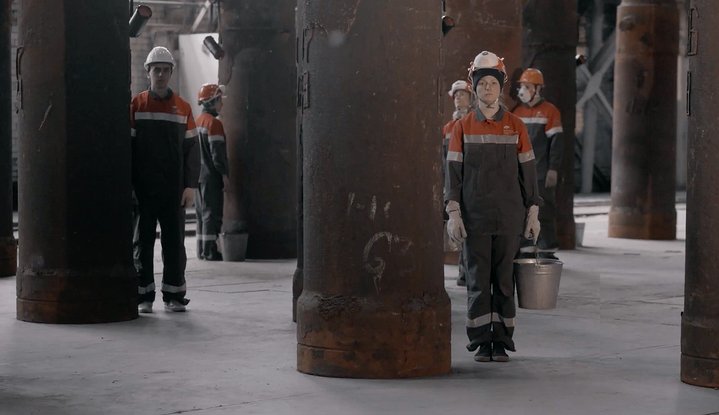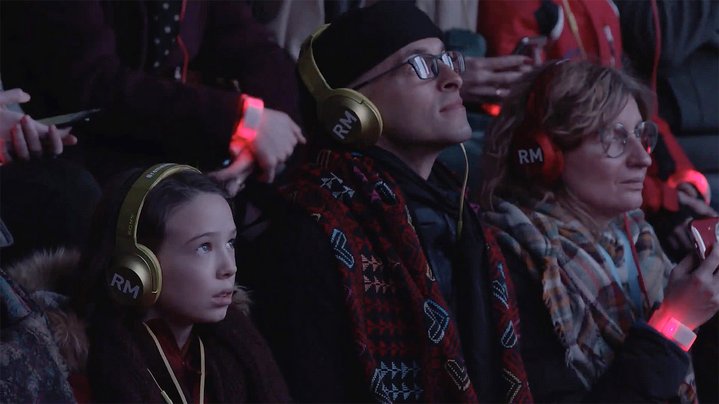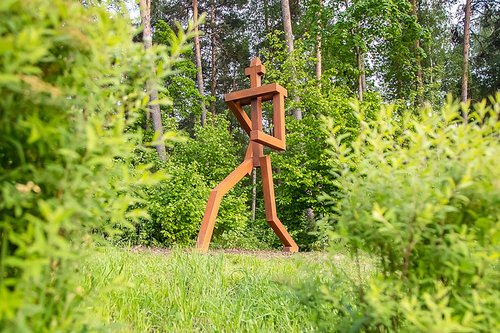An Assembly-Line of Ideas: Does Performance Art belong in a Factory?

Passions over Martin. Сhoreography by Anna Abalikhina. Music by Alexey Sysoev. Courtesy of the Vyksa Festival
Contemporary Artists and theatre directors in Russia are increasingly using factories as performance spaces, despite the multiple challenges that such projects incur. Whether disused or operational, factories provide thought-provoking venues for creative undertakings.
Staging an exhibition in a disused factory about a disused factory is a Kafka-esque initiative. Inspired by the industrial legacy of the USSR, an exhibition by Krasnodar-born artist Julia Shafarostova’s (b. 1991) is currently on view at Moscow's Fabrika Centre for Creative Industries, called the ‘Symphony of Consumer Goods’. Having researched the archives of the Electrozavod in Moscow, she wanted to immerse viewers in the absurd world of the Soviet ‘planned economy’ where the Communist Party dictated production not market demand. This turned the communist empire on its head: they sent a human-being into outer space for the first time in history, yet simple goods such as irons and fridges were hard to come by. Shafarostova’s exhibition takes place in one such failed Soviet enterprise. Fabrika is a former factory whose labyrinthine spaces are now used for art exhibitions and artists' studios or are leased to small businesses. Historian Sergey Nikitin-Rimsky created an immersive performance at Electrozavod, where the spectators were assigned roles as former employees. Some of them were the German workers and engineers who were first hired by the Soviet government and later executed as spies.
Fascination with the industrial past is a big trend in Russian art and culture today. Over several decades now, all across the world industrial buildings have been converted into new cultural spaces and Russia is no different – two of the biggest projects are in Moscow, Vinzavod a former wine-bottling factory and GES-2, a former power plant. In Russia there is also a proliferation of underfunded, grassroots initiatives with artists staging performances in ungentrified, abandonned or even working factories.
This kind of practice dates back to the early days of Russia’s rapid industrialization after the 1917 Bolshevik revolution. Avant-garde artists in that era were fascinated by technology. In 1923, composer Arseny Avraamov (1886-1944) created ‘The Symphony of Sirens’, a complex piece of music in which the whole city turned into and orchestra of instruments. It was played by the factory sirens all over town, car and airplane engines, church bells, and occasional gun and cannon shots. During Avraamov’s lifetime, it was only performed twice, in Baku and in Moscow. In 2017, a new recording created for Documenta 14 in Athens sounded both dreamlike and contemporary. Avraamov’s idea of the synergy of art and technical progress feels relevant in the era of Art & Science. Recently, Russia-born artist Andrei Molodkin (b. 1966), who has been living in France for many years, made an exploding safebox a crucial part of a politically charged artwork: filled with works by Picasso, Warhol, and a few living artists, it will explode if Julian Assange dies in custody.
In 1924 it was the great pioneer of avant-garde cinema Sergey Eisenstein (1898-1948) who first used a working factory as a space for a theatrical performance in ‘Gas Masks’. Based on a play by Sergei Tretyakov, it is a cliched early Soviet melodrama about a neglient factory manager whose hard-working staff (including his own son) die because he has not given them gas masks. It was initially performed in a real gas factory in Moscow, yet the production turned out to be a complete failure, butchered by critics, audiences complained about the noise and smell of gas during the performance, and the workers themselves at the factory were not impressed. The factory administration, initially supportive, eventually declared it was hindering work and after just three performances the play was moved to a theatre. Eisenstein himself admitted later that theatre props and sets were dwarfed by real factory equipment, its powerful movements, and disturbing sounds. Disappointed by this fiasco, the director lost interest in the theatre and turned to the cinema instead, the following year creating his groundbreaking masterpiece ‘Battleship Potemkin’ (1925).
The Ural Industrial Biennale (2010-2021) held in the city of Ekaterinburg has attempted to create a connection between Russia’s industrial legacy and its contemporary art. At first, the Biennale’s main exhibition took place in abandoned buildings such as a former typography, a hotel, and a factory, where visitors were captivated by both the art and the impressive structures which had previously been closed to the public. The last two editions of the Biennale took place at a working factory which produces location systems for the Russian army and navy. In 2019, the installation process was deferred because of the factory’s tight security, so the international flock of visitors to the preview of the 5th edition had to wait for hours to enter the exhibition, which was only half-ready. The program of the 6th edition in 2021 included a powerful parallel project by artist Pavel Otdelnov (b. 1979) called ‘Ringing Trace’. Located in a village on a lake over a hundred kilometres from the city, the exhibition has been so successful, that it has never been taken down. It is dedicated to a fatal incident at a secret Soviet research lab, which polluted the whole surrounding area with radioactive waste. Otdelnov’s exhibition which includes paintings, archival materials, and installations is in an abandoned dormitory building for the laboratory staff. Here there is a perfect match between the content and location. The derelict building has become in itself a monument to the people who used to live in it and who became both culprits and victims of the catastrophe. In the Autumn of 2023 theatre director Dmitry Zimin (b. 1986) developed a pod play (a site-specific audio performance) based on the memoirs of one former employee of the laboratory, 94-year-old Argenta Titlyanova. Visitors wearing headphones roam through the campus and visit the exhibition while listening to her story, told in first person.
Now, with the Urals biennale on hold, the creative team is looking for new ways to work with the industrial context. They recently launched a new initiative called ‘Night of Factories’: a festival of site-specific performances in different factories not just in Ekaterinburg but all over Russia which took place simultaneously on the same night in August. In 2023, the program included events across 18 industrial spaces, some of them working, some disused, and others already converted into cultural venues. Two of these venues, the Octava industrial cluster and Machine-Tool Museum in Tula are funded by Rostekh, a state-owned corporation that produces weapons, ammunition, and military equipment, among other high-tech products.
One of the most celebrated factory shows was ‘Passions over Martin’ at the Art Ovrag festival. It took place in 2018 in the industrial town of Vyksa, somewhere deep in the woods in the Nizhny Novgorod region in Central Russia. Staged by choreographer Anna Abalikhina (b. 1981), the performance took place in a metallurgical plant, around an old and polluting Martin furnace, that was finally put out of action. The furnace itself was the protagonist of the show. During the performance it erupted with water instead of boiling liquid steel. The cranes moved and the sirens yelled, while dancers and singers dressed in workers’ uniforms made pirouettes on the factory floor to a musical score written by Alexey Sysoev (b. 1972). A few trees were planted during the finale, to mark the improving ecology of the town and the project won the Grand Prix of the prestigious Kuryokhin Award.
To celebrate his 60th birthday, inspired by this example, industrialist and press tycoon Alexander Lebedev, the principal shareholder of The Evening Standard, commissioned a site-specific performance at his power-engineering factory in a town named after Chekhov near Moscow. The work, called ‘The Mystery of High Pressure’ was directed by Yuri Kvyatkovsky (b. 1982) and produced by Julia Bychkova and Anton Kochurkin. It took place on a Saturday when the factory was not operating. Spectators moved from one space to another on foot and in platform trucks, to watch various performances consisting of dancing, opera, drama, and circus acts. Fragments of interviews with female workers were projected on giant moving screens. The piece was performed only once, for the amusement of Lebedev’s family, friends, and a group of somewhat incredulous journalists. No tickets were sold for the event, and none of the workers at the factory were invited.
A ‘factory kitchen’ in Samara, where during the Soviet times mass-produced lunches were cooked and served to the workers of a nearby factory is being turned into a future branch of the State Tretyakov Gallery. Its opening has been postponed several times, yet the enormous, hammer and sickle shaped building has already hosted a site-specific show called ‘Utopia for Dinner’. Another one-time production by Anna Abalikhina and Alexey Sysoev, it was created for the guests of the museum’s pre-inaugural celebration in 2020. With mystical undertones, it featured performers marching with stacks of empty plates, startling light and sound effects, and scattered with quotes taken from Nikolai Gogol’s horror story, ‘Viy’.
It seems that performances in abandoned industrial spaces can offer more creative freedom and fewer logistical challenges for artists: they are easier to produce, more accessible to the public, and generally richer in meaning than the ones produced in factories which are in use. Balancing the interests of owners or sponsors and the creatives is another complex issue: it is easier to talk about the damage to the environment caused by a disused laboratory than a working factory that employs half of a town’s population. Yet, finding the balance, disclosing hidden tensions, and overcoming difficulties is the very substance of art.
Pavel Otdelnov. Ringing Trace
Sokol, Chelyabinsk region, Russia
September 2021 – ongoing
The Symphony of Consumer Goods
Fabrica Centre for Creative Industries
Moscow, Russia
21 November, 2023 – 31 May, 2024













